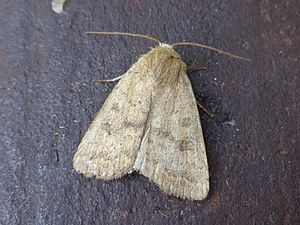Gorse heather ground owl
| Gorse heather ground owl | ||||||||||||
|---|---|---|---|---|---|---|---|---|---|---|---|---|

Gorse heather ground owl ( Xestia castanea ) |
||||||||||||
| Systematics | ||||||||||||
|
||||||||||||
| Scientific name | ||||||||||||
| Xestia castanea | ||||||||||||
| ( Esper , 1798) |
The gorse heather ground owl ( Xestia castanea ), also called gorse heather ground owl , red-brown heather owl and maroon ground owl , is a butterfly ( moth ) from the family of owl butterflies (Noctuidae).
features
butterfly
The moths reach a wingspan of 36 to 43 millimeters. On the forewings, fox-red to maroon tints often dominate. In some areas, however, specimens with a light ocher-gray base color are predominant. The kidney flaw is filled gray-black in the lower part. Other drawing elements are mostly indistinct, only weakly indicated or missing entirely. This means that there is little risk of confusion with other species. The hind wings are dark gray without drawing, the fringes shimmer lighter.
Egg, caterpillar, pupa
The whitish egg has a flat, hemispherical shape with strongly wavy, but weakly developed ribs. It later gets brownish-red spots.
Adult caterpillars vary greatly in their drawing and coloring and can produce greenish, brown or reddish animals. They are characterized by a wide, white lateral line that is sharply delimited upwards. The lines of the back and the side of the back are only slightly pale. Each segment has four small point lumps on the back. The head and pronotum are glossy yellow-brown in color, the head has a black grid pattern, and the pronotum has a light central line.
The red-brown doll shows two thorns on the cremaster .
differences
The typical features are the black spot in the kidney blemish and the reddish fringes of the hind wings.
Geographical distribution and habitat
The species occurs from Scotland and Fennoscandinavia in the north through Central Europe to the Urals (Russia) in the east. In the Mediterranean area, the species is distributed from Morocco across the Iberian, Apennine and Balkan Peninsula to Turkey, Lebanon, Syria and Israel.
The gorse heather ground owl prefers dry areas such as heaths, dwarf shrub heaths, embankments, as well as semi-arid grasslands and sparse pine forests.
Way of life
The gorse heather ground owl forms one generation per year. The main flight time of the nocturnal moths are the months of August and September. You visit artificial light sources as well as the bait , and occasionally the flowers of heather ( Erica ) or butterfly lilac ( Budleja davidii ). The caterpillars can be found from October. They are nocturnal and rest in grass clusters during the day. They feed on various plants, preferably on:
- Wire Schmiele ( Deschampsia flexuosa )
- Trembling poplar ( Populus tremula )
- Blackthorn ( Prunus spinosa )
- Common broom ( Sarothamnus scoparius )
- Common heather ( Calluna vulgaris )
- Blueberry ( Vaccinium myrtillus )
- Dyer's gorse ( Genista tintoria )
- German gorse ( Genista germanica ).
They overwinter "small" and pupate in a cave in June of the following year. According to Bergmann, the puppet rest is five to six weeks.
Danger
The gorse heather ground owl is usually rare in Germany and is listed in Category 2 (endangered) on the Red List of Endangered Species .
Taxonomy and systematics
The species was first scientifically described in 1798 by Eugen Johann Christoph Esper as Noctua castanea . According to the variability, there are numerous synonyms.
swell
Individual evidence
- ↑ a b Red Lists at Science4you
- ↑ a b Fibiger (1993: p. 169/170)
- ↑ a b c Axel Steiner in Steiner & Ebert (1998: pp. 460–463)
- ^ Eggs of Xestia castanea
- ^ Forster & Wohlfahrt (1971: p. 57)
- ↑ VD Kravchenko, M. Fibiger, J. Mooser and GC Muller: The Noctuidae of Israel (Lepidoptera: Noctuidae). SHILAP Revista de Lepidopterología, 34 (136): 353-370, Madrid, 2006 PDF ( page no longer available , search in web archives ) Info: The link was automatically marked as defective. Please check the link according to the instructions and then remove this notice.
- ↑ a b Bergmann (1954: p. 178/9)
- ↑ Eugen Johann Christoph Esper: The butterflies in illustrations according to nature with descriptions. Part IV: The owl phalas. The European Butterflies Fourth Part, Volume Two, Second Section, which contains Tom's owl phalas. IV. Tab.CLXXIX. Noct. 100 - Tom. IV. Tab. CXCVIII. Noct. 119. and contains sheets A to M. Pp. 1–85, plates 179–198, Walther, Erlangen 1805 Online at Biodiversity Heritage Library (description on p. 27/8).
literature
- Arno Bergmann: The large butterflies of Central Germany. Volume 4/2: Owls. Distribution, forms and communities. Urania-Verlag, Jena 1954, DNB 450378381 .
- Axel Steiner and Günter Ebert: The butterflies of Baden-Württemberg Volume 7, Nachtfalter V (Owls (Noctuidae) 3rd part), Ulmer Verlag Stuttgart 1998. ISBN 3-8001-3500-0
- Michael Fibiger: Noctuidae Europaeae, Volume 2 Noctuinae II. Entomological Press, Sorø, 1993, ISBN 87-89430-02-6
- Walter Forster , Theodor A. Wohlfahrt : The butterflies of Central Europe. Volume 4: Owls. (Noctuidae). Franckh'sche Verlagshandlung, Stuttgart 1971, ISBN 3-440-03752-5 .
Web links
- Lepiforum eV photos
- www.schmetterlinge-deutschlands.de Endangerment
- UK moths - website by Ian Kimber
- Xestia castanea - Butterflies and Moths of Northern Ireland
- Xestia castanea in Fauna Europaea